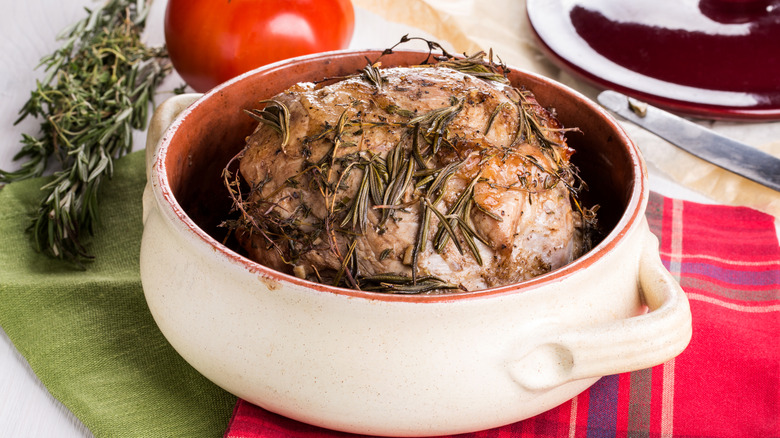Why Martha Stewart Recommends Braising Pork Shoulder With The Fat Side Up
When it comes to braising pork shoulder, it almost seems like there's no wrong way to do it. The cut of meat is so rife with fat and connective tissue, that the moist, gentle heat over a relatively long cook time renders a succulent end product every time. That said, even with the simplest of recipes, there are tips and techniques that help optimize braised pork shoulder. From searing the meat to how you season it and what liquid you braise it in, many factors come into play. So, when the esteemed Martha Stewart offers up a pointer for how to better braise pork shoulder, we're all ears.
As mentioned, this cut of meat contains no small amount of intramuscular fat. During the braising process that fat melts, keeping the meat moist, unctuous, and flavorful. But pork shoulder also features a thick layer of fat on one exterior side. If the pork shoulder is rind- or skin-on, that fat is located under the skin, otherwise it will be apparent on one side of the cut. It too will melt as the pork shoulder cooks, but how and where it melts can be slightly controlled to an advantage. Stewart, in a YouTube video detailing braised pulled pork, recommends positioning the pork shoulder so that the fat side is up towards the top of the braising vessel. While cooking, that fat renders slowly, all the while dripping down and basting the meat below in a moistening and protective fashion.
Brown, braise, and serve
To start, season the pork shoulder to your taste. Stewart, in her recipe, aims to mimic the flavors of traditional smoked barbecue. Thus she uses seasonings that you might find in a barbecue rub, such as cumin and paprika. You can use whatever works for your preference or recipe at hand. One important element, though not absolutely necessary, is sugar, which Stewart deploys to get a nice color on the pork shoulder.
That brings us to searing, a critical step before the actual braising can begin. Searing the pork shoulder helps develop a deep flavor by browning the exterior and promoting the Maillard reaction. The sugar that Stewart and others use in braises caramelizes on the exterior and furthers the browning process. While technically pork shoulder and other meats can be braised without browning, it goes a long way to creating a complex final product. Begin by searing the fat side first until it is nicely bronzed, then repeat the process on all other surfaces.
Now it's time to braise. Position the pork shoulder fat side up and add your braising liquid, which can be water, stock, wine, beer, or any other liquid, as well as aromatics, like garlic cloves, herbs, or vegetables. Cover the braising vessel tightly and place the whole thing in a low oven for several hours to work its magic. The reward will be a rich pork shoulder that has benefitted from a blanket of slowly melting, flavorful fat.

